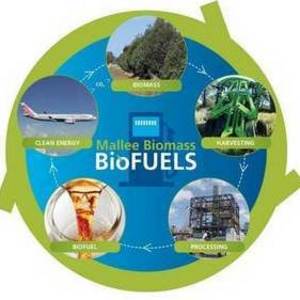Australian report finds potential for mallee tree-based jet fuel

June 9, 2014
BY Future Farm Industries Cooperative Centre
Aircraft powered by biofuel made from Australian mallee trees is not only possible, but could be sustainable and give a boost to potential new regional industries, according to a recent report published by the Future Farm Industries Cooperative Centre.
The mallee jet fuel sustainability and life-cycle assessment report—produced with funding from Airbus and support from industry partners Virgin Australia, Renewable Oil Corporation, Dynamotive and IFPEN—provides enough evidence to support continued R&D on mallee production and bio-oil upgrading, and to inform the business case for commercial production starting in Western Australia.
The report was launched during the CRC Association conference in Perth with key airline representatives present, including Airbus New Energies Programme Manager Frédéric Eychenne, and Virgin Australia Regional Airlines Group Executive Merren McArthur.
“We already know that mallee growing integrates well with farm crop and livestock operations and can benefit natural resources in a number of ways, such as protecting and enhancing biodiversity, and contributing to rebalancing water tables,” McArthur said. “What this report demonstrates is that mallees can provide a future economic benefit to farmers and regional communities, with a viable industry possible by 2021. The scenario tested was based on what we know from existing plantings, and indicates that mallees could occupy up to six per cent of paddocks, or about one per cent of the Great Southern region.”
Advertisement
The proposed mallee-based biofuels industry—including harvesting, transport and production—could provide employment for 40 people and bring about $30 million per year with the first regional plant.
The life-cycle carbon emissions analysis estimated jet flights leaving Perth Airport powered by 100 per cent mallee jet fuel sourced from Great Southern region farms could emit 40 percent less greenhouse gases compared to those using petroleum-based jet fuel.
Great Southern farmers growing mallees on marginal cropping soils will benefit from higher profits and more uniform income, offsetting variable crop income.
Advertisement
Importantly, integrated trees only cover a small part of the landscape so mallees grown for jet fuel would not significantly displace food crops. As it is a ‘second-generation’ biofuel coming from a woody source and not food crop, it does not compete directly with food supplies.
“Virgin Australia remains committed to supporting innovative Australian research into the feasibility of aviation biofuels and reducing greenhouse gas emissions in Australia,” McArthur said. “As the sole airline partner of this ground-breaking study, the results show mallee jet fuel is a more sustainable option than our current fossil-based fuel supply while also providing valuable insights into potential new supply chain developers. We look forward to supporting the mallee jet fuel project as it continues to evolve and getting one step closer to seeing a commercial supply of biofuel developed in Western Australia.”
Speaking at the Perth launch, Eychenne said, “The outcome of this report is very positive and supports Airbus’ global strategy of seeking the best local solutions for the development and commercialization of sustainable fuels for aviation. Since 2008 Airbus has been engaged in a worldwide programme to develop solutions, and this report is an important step towards achieving the goals the industry has set itself for carbon neutral growth.”
The mallee jet fuel sustainability and life-cycle assessment report and information on the CRC’s woody crops research can be found on the CRC’s New Woody Crop Industries research page, where you can also download the four-page brochure 'Mallee jet fuel to Perth Airport.
Future Farm Industries CRC will cease operation on 30 June this year, bringing to a close seven years of research into profitable perennial plant farming systems for Australian broadacre agriculture. The CRC’s research projects have either been completed or transferred to other state agencies or funding bodies.
Related Stories
A small but increasing amount of biodiesel in the United States is consumed in the residential, commercial, and electric power sectors, according to new estimates now published in the U.S. EIA’s State Energy Data System.
IAG and Microsoft are extending their 2023 co-funded purchase agreement for SAF by five years. The SAF used under the agreement will be produced by Phillips 66’s Humberside refinery and LanzaJet’s facility in the U.S.
Neste and DB Schenker, a logistics service provider, have collaborated to work towards expanding DB Schenker’s adoption of Neste MY Renewable Diesel in Asia-Pacific. DB Schenker trialed the fuel from December 2024 to February 2025 in Singapore.
U.S. operatable biofuels capacity increased slightly in January, with gains for ethanol, according to the U.S. EIA’s Monthly Biofuels Capacity and Feedstock Update, released March 31. Feedstock consumption was down when compared to December.
Effective April 1, Illinois’ biodiesel blend requirements have increased from B14 to B17. The increase was implemented via a bipartisan bill passed in 2022, according to the Iowa Soybean Association.
Upcoming Events










